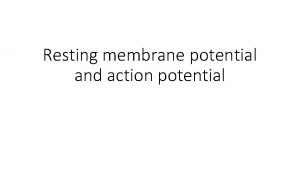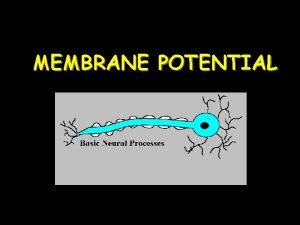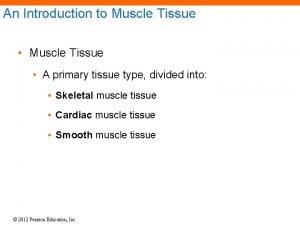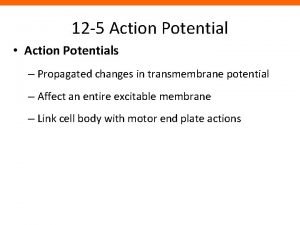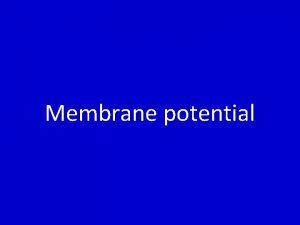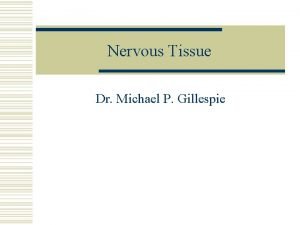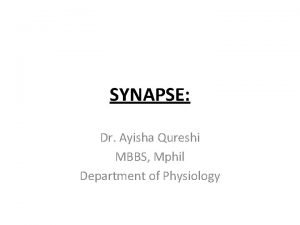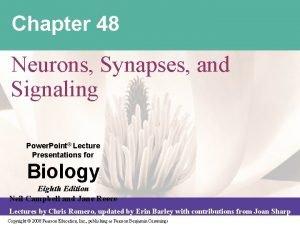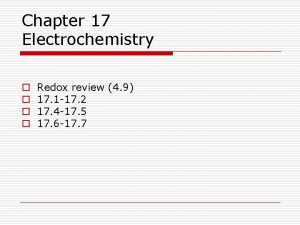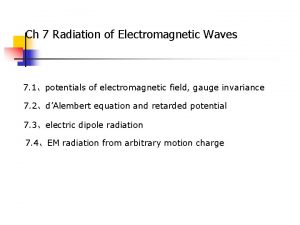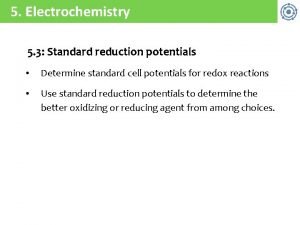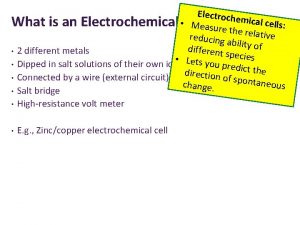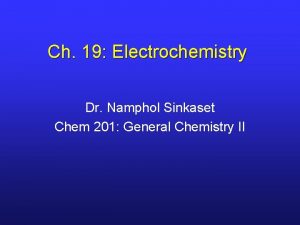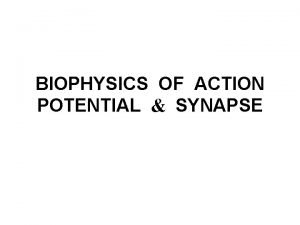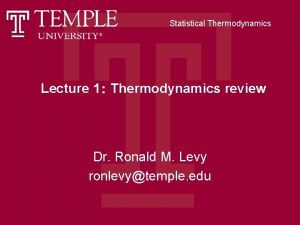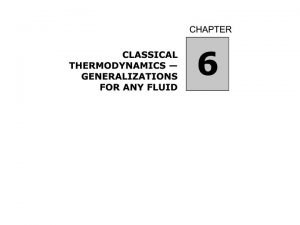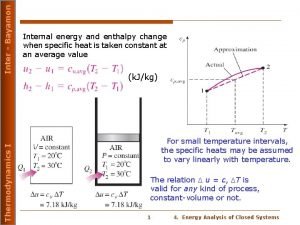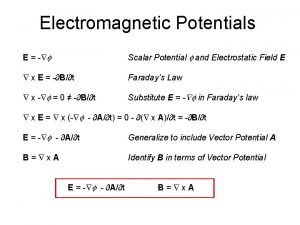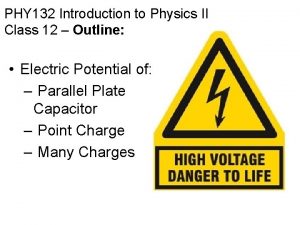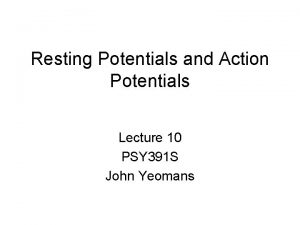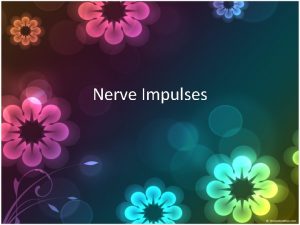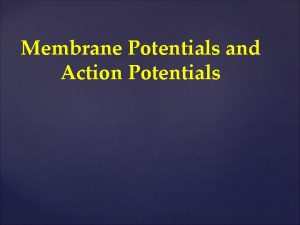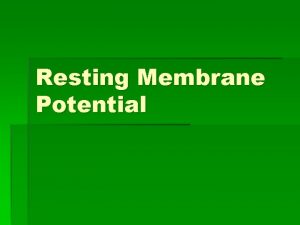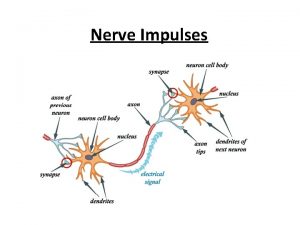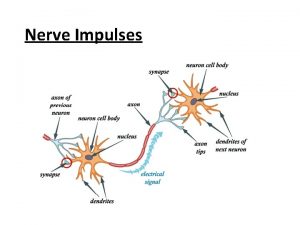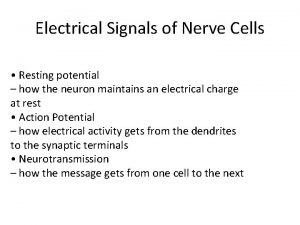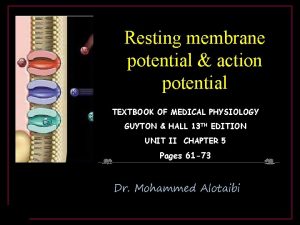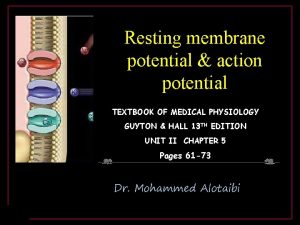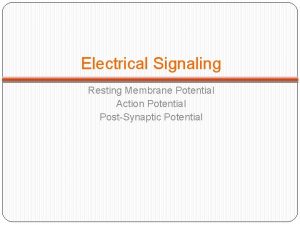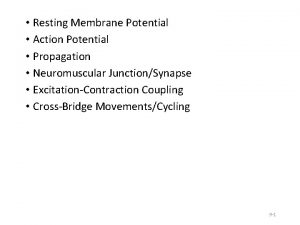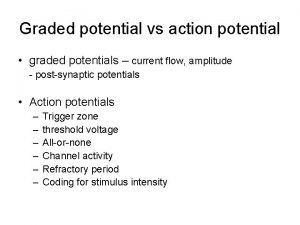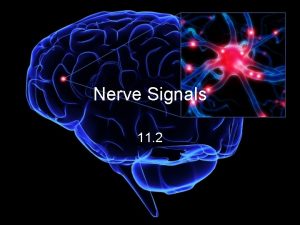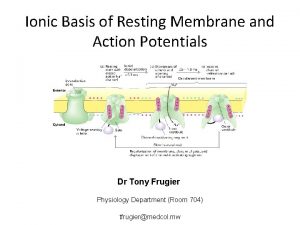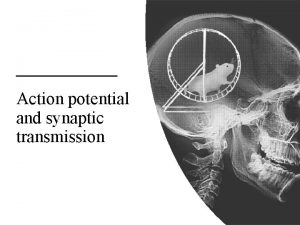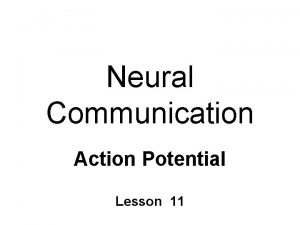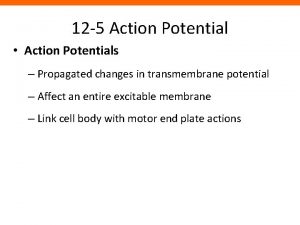Nerve Signals Action Potentials Resting Potential Resting refers

































- Slides: 33

Nerve Signals: Action Potentials

Resting Potential ‘Resting’ refers to moments where a neuron is not conducting an action potential (nerve signal). - During these moments, neurons maintain an electrical potential (a relative voltage difference) across their axomembranes of -65 m. V. It is for this reason that axomembranes are said to be polarized. To keep things simple, the ECF voltage is given a value of 0 m. V. • Thus, relatively speaking, the inside of an axon is more negative (or less positive) in charge than the outside of an axon (ECF). • Such a potential is measured by an oscilloscope, which is a voltmeter specially designed to test neurons. • This difference in charge exists due to a number of factors:

i. A Na+/K+ pump (carrier protein) maintains an unequal distribution of Na+ and K+ across an axomembrane – there naturally exists a higher [Na+] outside the neuron (in the ECF), and a higher [K+] inside the neuron (in the axoplasm). This, in itself, does not contribute to the negative cell potential, but the fact that the pump actively moves 3 Na+ out for every 2 K+ in (this is done primarily after nerve signals to reset the neuron) contributes to there being, at any one time, more cations outside than inside the neuron; thus contributing to the relative negative polarity across the axomembrane. The pump, which moves these ions against their concentration gradients, serves to maintain the steep concentration gradients mentioned with respect to Na+ and K+ (important for nerve signals).

ii. Na+ and K+ possess specific channel proteins (more for K+) that allow for a slow leakage of ions down their concentration gradients. K+ leaks out about 50 x faster than Na+ leaks in promotion of negative resting potential (there are very few of these ‘open’ channels compared to the soon-to-be-mentioned ‘gates’ that open during an action potential). The pump acts to continuously correct leakage. iii. There exist plenty of large negatively-charged molecules or anions within the neuron (proteins, amino acids, sulfate, phosphate), which cannot move out of the cell (either too large or possessing no specific channel proteins), thus creating a perpetual contribution of negative charge inside. iv. The [Cl-] is greater outside than inside (seems counterintuitive), which keeps resting potential at -65 m. V and not less than that. See fig. 17. 4(a) p. 325.


Methods of Ion Transfer Across Axomembrane 1. Channel Protein Diffusion: this refers to the leakage of Na+ and K+ ions, mentioned earlier; 2. Active Transport – Na+/K+ Pump: moves ions against their concentration gradients to ‘reset’ neuron for another action potential (ie. re-establishes steep gradients required for Resting Potential); 3. Protein Gates (Diffusion): one-way protein gates, of which there are two types: i. Na+ gates (when open, these gates specifically allow Na+ into an axon (down its conc. gradient)); ii. K+ gates (when open, these gates specifically allow K+ out of an axon (down its conc. gradient)). - These gates will be discussed in further detail during analysis of action potentials. However, it is important to mention that these gates, when opened, serve as the primary mechanism by which Na+ and K+ move into/out of the neuron as they vastly outnumber the ‘always open’ channels mentioned earlier. An action potential requires a flood of ions in either direction – thus the need for the numerous gates.

Action Potential (an actual Nerve Signal!) • The signal transmitted along the length of a neuron, from a dendrite, cell body, or axon hillock to the synaptic endings of an axon, is an electrical signal that depends on a rapid, localized flow of ions across the neuron’s membrane. • This signal (flow of ions across the membrane) then travels along a neuron, perpendicular to the ion flow direction. • All cells possess a membrane potential of some kind, but only neurons (and muscle cells) have the ability to generate changes in that potential (and thus, generate a signal).

• A stimulus is usually received by a dendrite - the stimulus can be pressure, temperature, light (eyes), or chemical and it is received by specific protein receptors on the dendrites. • Chemical stimuli usually arrive from other neurons, or from the internal environment, whereas the other stimuli (temperature, light, pressure) usually arrive from the external environment. • The stimulus is passed to the cell body, which then integrates it. If the stimulus is ‘weak’, it will not reach the axon hillock; if it is ‘medium’-‘strong’, it is passed on to the axon hillock. • If the stimulus is strong enough, it will cause the axomembrane of the axon hillock to depolarize to a certain degree (ie. the axoplasm will become less negative in charge). If that certain degree of depolarization reaches a certain threshold, an action potential (AP) will result. • How does the depolarization occur? See fig. 17. 4(b) p. 325

-40 -65 Resting Potential

Steps: 1. RESTING POTENTIAL – -65 m. V 2. DEPOLARIZATION – a stimulus reaches the axon hillock and triggers Na+ gates to open. A stronger stimulus opens more gates, whereas a weaker stimulus opens less. The opening of the gates allows Na+ to move into the axoplasm (which Na+ is able to do easily since they are moving down their concentration gradient and are electrostatically attracted to the -65 m. V axoplasm). If the stimulus is strong enough, and enough Na+ enters, then threshold potential (– 40 m. V) will be reached and ALL remaining Na+ gates open (an example of positive feedback), so that Na+ floods the axoplasm. Na+ equilibrium (with respect to charge and concentration) is reached when the potential across the axomembrane (axoplasm charge) equals +40 m. V. Depolarization (APs) are referred to as ‘All-or-None’ meaning that threshold is either reached, or not reached. If threshold is not reached, the signal ‘dies. ’

3. REPOLARIZATION – once Na+ equilibrium is attained, the Na+ gates close. The closing of the Na+ gates signals the K+ gates to open. K+ then diffuses OUT of the axoplasm into the ECF (down its concentration gradient and repelled by the +40 m. V axoplasm charge). K+ equilibrium is attained at about – 80 m. V (called the undershoot). The K+ gates then close. 4. REFRACTORY PERIOD – two points to make: a. Excess K+ in ECF diffuses away to re-establish the – 65 m. V resting potential. b. During this time, the neuron is unable to process another stimulus and create another AP – this because Na+ gates are unable to open during the Refractory Period. This also disallows a backward AP whenever one is initiated at the axon hillock.

- Once depolarization is complete, and the refractory period passes, that particular section of the axon is able to ‘fire’ again – this is due to the fact that, even though Na+ and K+ ions changed places and did not return, only a small percentage of the TOTAL Na+ and K+ swapped locations. A section of an axon may fire multiple times before it requires a Recovery Period (Ion Redistribution Period), where both gates shut down so that the Na+/K+ pump can move the ions back to where they originally came from.

As a class, let’s re-draw an Action potential curve…

All-or-None Depolarization - Action potentials are all of equal strength (ie. if a stimulus reaches threshold, the membrane potential reaches +40 m. V). “ALL” - If a stimulus fails to reach threshold, the signal ‘dies’ and resting potential is re-established. “NONE” - So, how does a stronger stimulus affect nerve firing? - A stronger stimulus simply produces more APs per unit time than a weaker stimulus (that attains threshold). - Thus, the refractory period for a neuron conducting a stronger signal (more APs) is shorter than that of a neuron conducting a weaker signal (less APs). - This is important during stressful situations as, eventually, neurons need a recovery period (pump working feverishly), yet the signal must persist – this is where hormones come into play to maintain a signal.

Propagation of an Action Potential (Domino Effect) • An AP (depolarization/repolarization) is a localized event that tends to originate at the axon hillock. • APs need to ‘travel’ along an axon to carry the signal – the ‘traveling’ is actually due to simple diffusion of Na+ within the axoplasm. • Once Na+ floods the axon (depolarization), the ions diffuse perpendicularly in both directions within the axon. • Na+ that diffuses forward in the axon allows the axoplasm in this ‘non-stimulated region’ to reach threshold (cations raise voltage to – 40 m. V), which triggers the Na+ gates in this ‘new’ axon region to open, so that more Na+ may flood across the axomembrane. • The Na+ that flows backward has no effect since that region of the axon is experiencing the refractory period where Na+ gates can not open for a period of time – thus, APs cannot travel backward.


Myelin • Myelin is a specialized lipid that serves as a neuron insulator by wrapping around axons (and dendrites in sensory neurons). • Myelin is composed by Schwann Cells (aka oligodendrocytes or neurolemmocytes). • Myelin serves to increase the speed of an AP’s (nerve impulse’s) propagation by simply acting as a physical barrier to ion flow (both Na+ and K+). • Axons are not continuously covered by myelin; the myelin sheath is interrupted at regular intervals by nodes (‘naked’ or ‘bare’ axon regions) called Nodes of Ranvier. • The specific Na+ and K+ gates congregate at the nodes in myelinated neurons – therefore, depolarization and repolarization may only occur at the nodes. • Thus, APs propagate (‘jump’) from node to node (known as Saltatory Conduction). • Non-myelinated neurons’ APs travel much more slowly.


Communication between Neurons and Other Cells • When an AP arrives at the many axon terminals (bulbs), the ‘signal’ must somehow be passed on to another cell for its desired effect to occur. • But, remember, axon terminals do NOT touch target cells (ie. axon bulbs and target cells are separated by a thin layer of ECF). • There are three possible target cells: i. Another Neuron – the connection is called a synapse; ii. Muscle Cell – the connection is called a neuromuscular junction/synapse; iii. Gland or Organ Cell – the connection is called a neuroglandular junction/synapse.

• Our main focus will be on the synapses between neurons, which conduct signals from an axon’s terminals to the dendrites (or cell bodies, in some cases) of the next neuron in a signal pathway. • The transmitting cell (the cell trying to ‘pass on’ the AP) is called the presynaptic cell and it possesses its own membrane, the presynaptic membrane. • The receiving cell (the cell destined to ‘receive’ the AP) is called the postsynaptic cell and it possesses its own membrane, the postsynaptic membrane. • The space between the two neurons is known as the synaptic cleft (really, it’s just ECF with a max. width of 0. 2 micrometers).


• There exist two types of synapses: Electrical and Chemical: • Electrical Synapses: allow APs to spread directly from pre- to postsynaptic cells. The cells are connected by gap junctions (recall SA node signaling in heart for atrial contraction), which allow for direct ion transfer between neurons (much faster, but more energy/coordination to create/control); chemical synapses FAR outnumber electrical synapses in the body.

Chemical Synapses (aka ‘Synapses’) see fig. 17. 5 p. 326 • The synaptic endings of presynaptic cells contain vesicles that are full of tiny chemical ‘messengers’ known as neurotransmitters; each vesicle is attached to the presynaptic membrane by a special, thread-like contractile protein (fiber) (primarily composed of actin – a microfilament). • The postsynaptic membranes possess multiple protein receptors for these neurotransmitters to bind to; a different type of neurotransmitter will bind to a different receptor and will produce a different resulting signal.

The Transmission Process: 1. When an AP arrives at an axon terminal, Na+ flood into the bulb. A depolarization within the bulb signals the opening of Ca 2+ gates (these gates are only located in axon terminals). Ca 2+ then flood the bulb and K+ leave to repolarize. Ca 2+ ions tend to congregate in synaptic clefts. 2. Ca 2+ bind to the contractile proteins and cause them to contract and shorten, thus pulling the vesicles housing neurotransmitter molecules to the presynaptic membrane. 3. Exocytosis occurs at the membrane in order to release the neurotransmitter into the synaptic cleft (many mitochondria exist within an axon terminal in order to promote this active process). Once enough vesicles have released their neurotransmitter, the ATP from the mitochondria helps to actively transport the Ca 2+ ions back out of the bulb into the synaptic cleft.


4. Chemical neurotransmitters simply diffuse across the synaptic cleft into the vicinity of the postsynaptic membrane/cell. 5. The neurotransmitters bind with their respective protein receptors that are anchored within the postsynaptic membrane. 6. One of six outcomes may occur depending on the type of postsynaptic cell and the type of neurotransmitter/receptor combination at work. Recall the three types of postsynaptic cells: another neuron, a muscle cell, or a gland/organ cell. The two different neurotransmitters that we talk about are norepinephrine (aka noradrenaline) (excitatory) and acetylcholine (inhibitory).

Type of Cell Neurotransmitter Another Neuron Muscle Cell Generates AP Causes muscle in postsynaptic cells to contract. Norepinephrine neuron by triggering Na+ gates to open. Acetylcholine AP not generated. Na+ gates not opened in postsynaptic membrane (*in fact, K+ gates open to cause hyper -polarization). Gland/Organ Cell Causes, for example, a gland to secrete an enzyme or hormone. Causes muscle Causes, for cells to relax. example, a gland to stop secreting an enzyme or hormone.

Norepinephrine initiates an excitatory postsynaptic potential (EPSP). Acetylcholine initiates an inhibitory postsynaptic potential (IPSP). 7. Receptors release the neurotransmitters back into the synaptic cleft after their signaling function is completed. To prevent perpetual stimulation or inhibition, these ‘used’ neurotransmitters need to be removed from the cleft. This is performed via one of the following: i. They are reabsorbed (endocytosis) by the presynaptic cell’s axon terminal. ii. They simply diffuse away from the receptors.

iii. They are destroyed by enzymes that exist near the postsynaptic membrane (the enzymes are activated when the neurotransmitter is released back into the cleft): Monoamine Oxidase destroys norepinephrine; Acetylcholinesterase destroys acetylcholine. * Some drugs work to promote a continued existence of neurotransmitters within the cleft so that their excitatory/inhibitory effects occur over a lengthy period of time (eg. Cocaine = excitatory; Heroin = inhibitory).


Summation/Integration at Synapses • A single neuron possesses numerous dendrites along with the cell body, each of which synapse with thousands of synaptic endings of other neurons in a relatively small volume of space (if you recall, many neurons are bundled into nerves). • Because the cleft is a ‘sea’, of sorts, many different neurotransmitters might be ‘floating’ around affecting many synapses. • Thus, a postsynaptic cell might be receiving a differing combination of excitatory and inhibitory neurotransmitters (eg. all of one type, or a mix of each), which possess the ability to cause either depolarization (opening of Na+ gates) or hyperpolarization (opening of K+ gates).

• The cell body and axon hillock then sum up (integrate) the ions received (Na+) and lost (K+) to ‘decide’ if threshold is reached (see fig. 17. 6 p. 327). • If threshold is not reached, no AP is generated in the axon hillock; • If threshold is reached, an AP is generated and continues at the same strength along the length of the axon to the postsynaptic cell’s synaptic endings.

 Sources of biopotential
Sources of biopotential Action potential resting potential
Action potential resting potential Action potential resting potential
Action potential resting potential Graded potentials
Graded potentials Graded potential vs action potential
Graded potential vs action potential Graded potential
Graded potential Difference between action and graded potential
Difference between action and graded potential Refractory period in action potential
Refractory period in action potential Hypopolarization
Hypopolarization Neuromuscular junction
Neuromuscular junction Communicative signals and informative signals
Communicative signals and informative signals Features of human language
Features of human language Communicative signals and informative signals
Communicative signals and informative signals What is resting membrane potential
What is resting membrane potential A&p flix activity: propagation of an action potential
A&p flix activity: propagation of an action potential The resting membrane potential of a neuron is
The resting membrane potential of a neuron is Titin
Titin Steps of action potential
Steps of action potential Eqion
Eqion Potencial de acción
Potencial de acción Postsynaptic potentials
Postsynaptic potentials Postsynaptic potentials
Postsynaptic potentials Standard reduction potential table
Standard reduction potential table Lienard-wiechert potentials
Lienard-wiechert potentials Standard cell potentials
Standard cell potentials Electroch
Electroch Use the tabulated half-cell potentials to calculate
Use the tabulated half-cell potentials to calculate Summation of postsynaptic potentials
Summation of postsynaptic potentials Thermodynamic potentials
Thermodynamic potentials Maxwell relations thermodynamics
Maxwell relations thermodynamics Gibbs free energy
Gibbs free energy What is cv in thermodynamics
What is cv in thermodynamics Magnetic scalar potential
Magnetic scalar potential Electric potential
Electric potential













